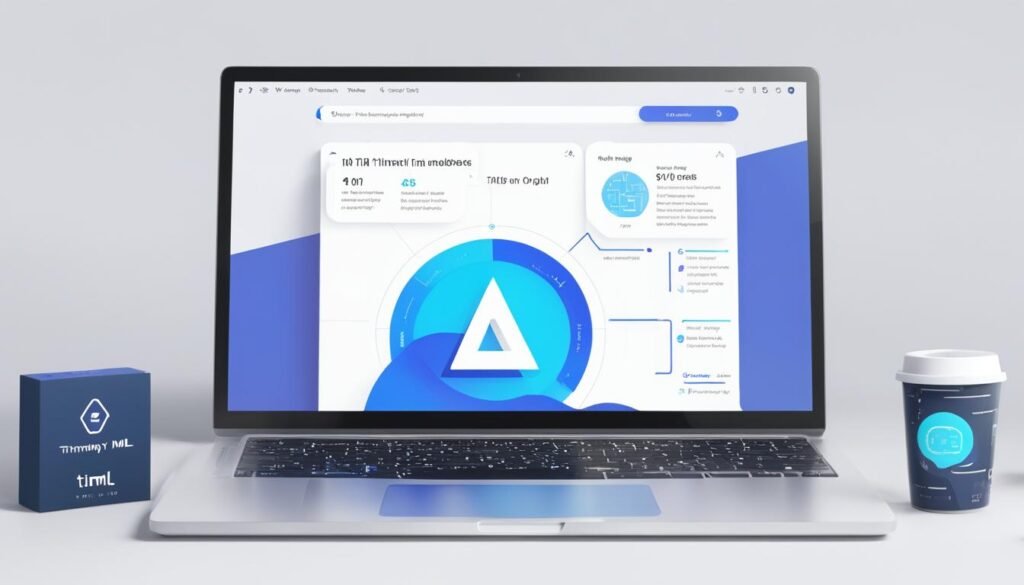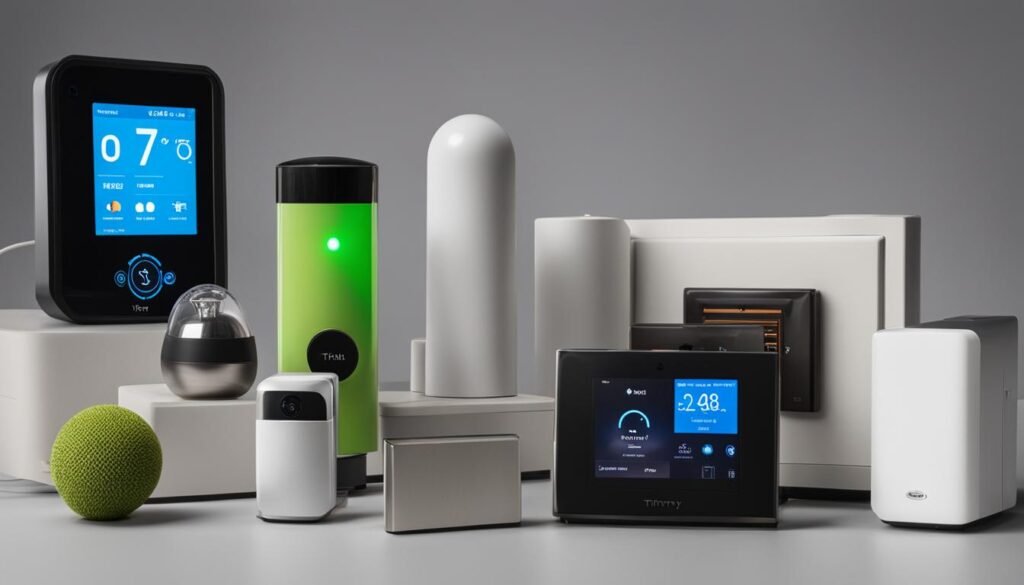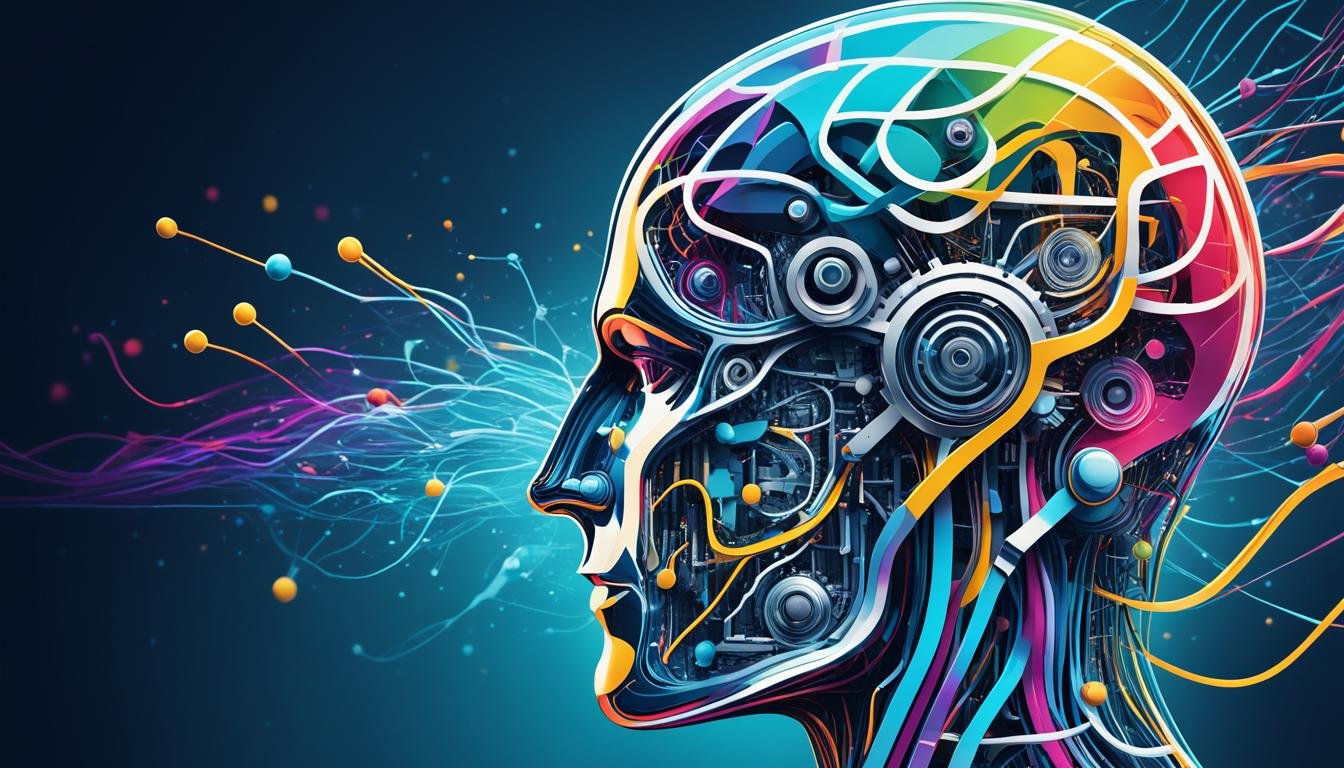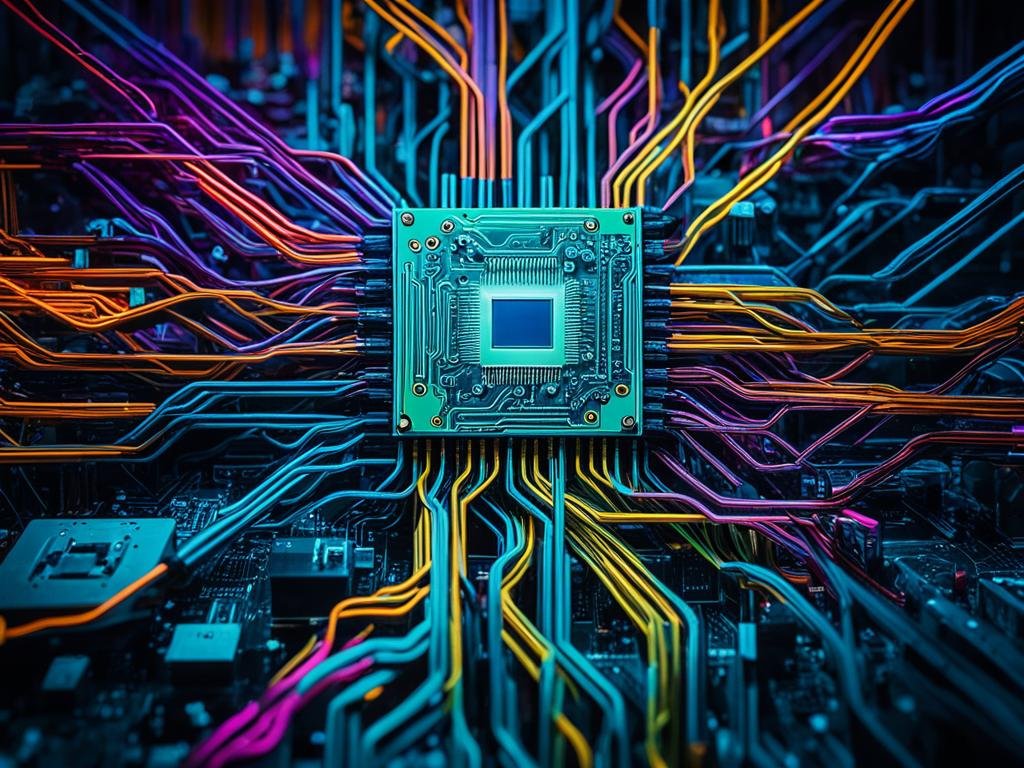Edge ML, also known as machine learning at the edge, is a groundbreaking approach that is transforming the field of on-device intelligence. With edge ML, machine learning models and processing capabilities are brought directly to edge devices, enabling faster and smarter decision-making in real-world applications.
Edge computing plays a vital role in edge ML by facilitating the deployment of AI algorithms on edge devices such as smartphones, IoT devices, and edge servers. This proximity to the data source allows for real-time data processing, minimizing latency and maximizing efficiency.
Key Takeaways:
- Edge ML revolutionizes on-device intelligence by bringing machine learning models and processing capabilities closer to the data source.
- Edge computing enables real-time data processing on edge devices, reducing latency and improving performance.
- Edge ML has applications in various industries, including healthcare, smart homes, industrial IoT, and more.
- Benefits of edge ML include faster processing, enhanced privacy, and reduced dependency on centralized cloud servers.
- As hardware capabilities improve and AI models become more efficient, the future of edge ML looks promising.
What is TinyML?
TinyML is a revolutionary approach to the development and deployment of machine learning (ML) models on resource-constrained devices. These devices, such as wearables, smart sensors, and drones, often have limited memory, processing power, and battery life. TinyML is particularly useful for Internet of Things (IoT) applications, including environmental monitoring systems, where data processing needs to happen directly on the device itself.
By enabling ML models to run on these resource-constrained devices, TinyML eliminates the need to send data to the cloud for processing. This addresses several challenges associated with cloud-based ML applications, such as latency, privacy concerns, lack of reliable internet connectivity, and high costs.
TinyML empowers edge devices to make intelligent decisions locally, without relying on external servers. This enables real-time processing and faster response times, making it ideal for applications that require immediate decision-making. Additionally, it enhances privacy by keeping sensitive data on the edge device, ensuring compliance with regulations and minimizing security risks.
The development and deployment of TinyML models require specialized techniques to optimize ML models for resource-constrained devices. These techniques include model compression, quantization, and optimization. By reducing the resource requirements, TinyML allows ML models to run efficiently even on devices with limited memory and processing power.
Here is a table highlighting the key characteristics of resource-constrained devices for TinyML:
| Device | Memory | Processing Power | Battery Life | Application |
|---|---|---|---|---|
| Wearables | Low | Low | Long | Health monitoring |
| Smart sensors | Low | Low | Long | Environmental monitoring |
| Drones | Low | Medium | Short | Aerial surveillance |
With the advancements in TinyML, these resource-constrained devices can now perform complex tasks and provide intelligent insights, all while overcoming the limitations posed by limited memory, processing power, and battery life. This opens up a wide range of possibilities for IoT applications, enabling innovation in wearables, smart sensors, drones, and more.
Benefits of TinyML
TinyML offers several key benefits that make it a game-changer in the world of edge machine learning. These benefits include reduced latency, enhanced privacy, offline functionality, lower costs, and wider accessibility.
- Reduced Latency: With TinyML, data is processed locally on the edge device, significantly reducing the time it takes to analyze and respond to information. This reduced latency enables faster decision-making and real-time action, making it ideal for applications that require immediate responses.
- Enhanced Privacy: By keeping sensitive data on the edge device, TinyML minimizes privacy risks and ensures compliance with regulations. This approach enhances privacy and data security by minimizing the need to transfer data to cloud servers for processing.
- Offline Functionality: TinyML models can operate offline, even without an internet connection. This makes them suitable for remote or disconnected environments where consistent internet connectivity may not be available. By enabling offline functionality, TinyML ensures continuous operation and reliable performance.
- Lower Costs: By leveraging edge computing resources instead of relying solely on cloud resources, TinyML significantly reduces operational expenses. This cost-efficiency makes it an attractive option for businesses, as it eliminates the need for high-bandwidth connections and reduces reliance on cloud infrastructure.
- Wider Accessibility: TinyML makes intelligent applications accessible on a wider range of devices. This expands the possibilities for innovation and impact, as TinyML models can be deployed on resource-constrained devices such as wearables, smart sensors, and drones. By making on-device intelligence more accessible, TinyML opens up new opportunities for intelligent applications in various industries.
Overall, the benefits of TinyML make it a powerful tool for edge machine learning, offering reduced latency, enhanced privacy, offline functionality, lower costs, and wider accessibility.

Challenges and Opportunities of TinyML
While TinyML offers immense potential, it also faces challenges in its implementation. Overcoming these challenges is crucial to fully harness the power of TinyML and unlock its benefits. Let’s explore some of the key challenges and opportunities in the field of TinyML:
Resource Constraints:
One major challenge in TinyML is working with resource-constrained devices. These devices often have limited memory, processing power, and battery life. Developing machine learning models that can run efficiently on such devices requires specialized techniques such as model compression, quantization, and optimization.
Limited Data Availability:
Another challenge in TinyML is dealing with limited data availability on the edge. Since edge devices often operate in remote or disconnected environments, collecting and utilizing data effectively becomes crucial. Efficient data collection and utilization strategies must be implemented to address this challenge.
Hardware and Software Development:
Continuous advancements in hardware and software development are essential to support the growing demands of TinyML applications. Hardware improvements, such as the development of specialized AI accelerators, enable more powerful and efficient TinyML models. Software development efforts focus on creating user-friendly frameworks and tools for TinyML development.
Opportunities for Innovation:
Despite these challenges, the rapid growth of TinyML presents significant opportunities for innovation and impact in various industries. By overcoming resource constraints and leveraging limited data, TinyML can enable intelligent applications on a wider range of devices, expanding the possibilities for innovation and addressing real-world problems.
Overall, addressing these challenges and embracing the opportunities in TinyML will pave the way for the widespread adoption of on-device intelligence, revolutionizing industries and empowering intelligent devices.
| Challenges | Opportunities |
|---|---|
| Resource Constraints | Development of specialized techniques for efficient model compression, quantization, and optimization |
| Limited Data Availability | Implementation of efficient data collection and utilization strategies |
| Hardware and Software Development | Continuous advancements in hardware and software, enabling more powerful and efficient TinyML models |
Promising Applications of TinyML
TinyML, with its capabilities to bring machine learning to resource-constrained devices, holds great promise for various industries. Let’s explore some of the exciting applications of TinyML:
In Healthcare
Wearables powered by TinyML can revolutionize healthcare by monitoring vital signs, detecting health conditions, and delivering personalized medical interventions. These devices provide real-time data analysis, enabling proactive healthcare management and improved patient outcomes.
In Smart Homes
TinyML-powered devices in smart homes can enhance comfort, convenience, and energy efficiency. These devices can intelligently adjust lighting and temperature, optimize energy consumption, and enhance home security. With TinyML, smart homes become more responsive and capable of adapting to the needs and preferences of the inhabitants.
In Industrial IoT
Industrial IoT applications benefit greatly from TinyML sensors. These sensors can monitor equipment health, predict failures, and optimize operational efficiency. By enabling proactive maintenance and minimizing downtime, TinyML empowers industries to achieve higher productivity and cost savings.
In Environmental Monitoring
Environmental monitoring systems can leverage TinyML sensors to track air quality, water quality, and noise pollution. These sensors enable real-time data collection and analysis, facilitating data-driven environmental management and sustainable practices.
In Agriculture
TinyML systems provide valuable insights for agriculture by monitoring soil moisture, optimizing irrigation, and improving crop yields. By enabling precision agriculture and efficient resource allocation, TinyML helps farmers enhance productivity and sustainability.
These applications highlight the potential of TinyML to transform different sectors and bring intelligence to a wide range of devices. With ongoing advancements and innovations in the field of TinyML, the possibilities for its applications will only continue to grow.

The Future of TinyML
The future of TinyML is filled with exciting possibilities, driven by ongoing research and development efforts that are pushing the boundaries of innovation. Hardware advancements and software development are paving the way for more powerful and efficient TinyML models, while model compression and optimization techniques are constantly evolving to reduce the resource requirements of these models. Let’s explore the future trends and developments in TinyML that are shaping the landscape of on-device intelligence.
Hardware Advancement
In the future, hardware advancements will play a crucial role in unlocking the full potential of TinyML. Neuromorphic chips and specialized AI accelerators are being developed to provide edge devices with the necessary computing power to handle resource-intensive TinyML models. These hardware innovations will not only enhance the performance of on-device intelligence but also enable more complex and sophisticated applications.
Software Development
Software development efforts are focused on creating user-friendly frameworks and tools that facilitate the development and deployment of TinyML models. These advancements aim to simplify the process of building TinyML applications, making them more accessible to developers across different domains. By streamlining the development workflow, software advancements will accelerate the adoption of TinyML and drive its growth.
Model Compression and Optimization Techniques
Model compression and optimization techniques are continuously evolving to make TinyML models more efficient and scalable. These techniques involve reducing the size of the models without compromising their performance, enabling them to run on even smaller devices with limited resources. As model compression techniques improve, TinyML models will become more versatile and capable of running on a wider range of edge devices, expanding the possibilities for on-device intelligence.
Standardization Efforts
Standardization efforts in the TinyML ecosystem are underway to ensure interoperability and collaboration among different stakeholders. These efforts aim to establish common frameworks, protocols, and standards that enable seamless integration and communication between TinyML platforms and devices. Standardization will drive innovation, encourage industry-wide adoption, and foster a collaborative environment for the growth of TinyML.
Growing Ecosystem
The TinyML ecosystem is witnessing rapid growth, with a growing community of researchers, developers, and companies contributing to its development. This expanding ecosystem fosters knowledge sharing, collaboration, and the exchange of ideas, facilitating the advancement of TinyML technologies. As the ecosystem continues to grow, we can expect to see more innovative applications and a wider range of use cases for TinyML.
Image:
| TinyML Advancements | Key Benefits |
|---|---|
| Hardware Advancement | More powerful and efficient TinyML models |
| Software Development | User-friendly frameworks and tools for easier development |
| Model Compression and Optimization | Reduced resource requirements for TinyML models |
| Standardization Efforts | Interoperability and collaboration in the TinyML ecosystem |
| Growing Ecosystem | More innovation and a wider range of use cases |
In conclusion, the future of TinyML is characterized by hardware advancements, software development, model compression and optimization, standardization efforts, and a growing ecosystem. These factors together will shape the future trends and advancements in TinyML, paving the way for a more intelligent and connected future.
What is Edge Computing?
Edge computing is a distributed computing architecture that brings data processing and decision-making closer to the source. Rather than sending data to centralized cloud servers, edge computing allows applications to run on edge devices like smartphones, IoT devices, and edge servers. This decentralized approach reduces latency, conserves bandwidth, and enables faster and more localized data processing.
By processing data on edge devices themselves, edge computing minimizes the need for data to travel long distances to reach cloud servers. This reduces the time it takes for data to be processed and enables real-time decision-making, making it ideal for applications that require near-instantaneous responses.
The use of edge devices, such as smartphones and IoT devices, in edge computing enables data to be processed closer to the point of generation. This localized data processing helps alleviate network congestion and offloads the burden on centralized servers, resulting in faster processing speeds and improved overall performance.
Edge computing also has advantages in terms of bandwidth conservation. By processing data locally, edge computing reduces the amount of data that needs to be transferred over the network, conserving bandwidth and optimizing network resources.
Furthermore, edge computing provides a more reliable and resilient solution in environments with limited or intermittent network connectivity. By enabling devices to operate independently without constant reliance on cloud services, edge computing ensures that applications can continue to run even when the internet connection is unstable or unavailable.
The dispersed computing architecture of edge computing enhances the security of sensitive data. By keeping data on the edge device itself, edge computing minimizes the exposure of data to potential security breaches that may occur during data transmission to the cloud. This approach helps address privacy concerns and mitigates the risks associated with transmitting data over public networks.
Overall, edge computing empowers devices to process data and make autonomous decisions closer to the source, leading to reduced latency, optimized bandwidth utilization, enhanced security, and improved reliability. The decentralized nature of edge computing architecture enables faster and more localized data processing, making it well-suited for various applications across industries.
Components of Edge Computing
The architecture of edge computing consists of several components that work together to enable efficient data processing and decision-making at the edge. These components include:
1. Edge Devices
Edge devices, such as smartphones and IoT devices, are the initial point of data collection in edge computing. They gather data from various sources and transmit it to the edge servers for further analysis and processing.
2. Edge Servers
Edge servers are located closer to the end users, minimizing latency and improving response times. They handle basic computations and perform initial data processing tasks, ensuring faster and more localized decision-making.
3. Edge Gateways
Edge gateways act as bridges between edge devices and the cloud. They regulate network operations, managing the flow of data between edge devices and cloud servers. Edge gateways play a crucial role in maintaining connectivity and facilitating secure communication.
4. Cloud Servers
Cloud servers, situated in centralized data centers, provide significant computational capabilities for processing and storing data that requires more extensive processing. These servers handle complex tasks and store data that can be accessed by edge servers and devices when needed. They complement the edge infrastructure by offering additional computational power and resources.
| Component | Description |
|---|---|
| Edge Devices | Collect and transmit data to edge servers |
| Edge Servers | Handle basic computations and initial data processing |
| Edge Gateways | Regulate network operations between edge devices and the cloud |
| Cloud Servers | Provide computational capabilities for extensive processing and storage |
Why Do We Need Edge Computing Machine Learning?
Edge computing machine learning offers several benefits in various industries. By processing data on the edge device itself, edge computing reduces latency, resulting in faster response times and better real-time capabilities. This enables businesses to make critical decisions more quickly and efficiently, leading to improved productivity and customer satisfaction.
Scalability is another advantage of edge computing machine learning. By distributing processing among devices, the burden on centralized cloud systems is reduced, allowing for seamless scalability as the demand for computational power increases. This flexibility ensures that businesses can efficiently handle growing workloads and adapt to changing needs without experiencing performance bottlenecks.
Enhanced security is a priority in today’s digital landscape, and edge computing machine learning plays a vital role in protecting sensitive data. By keeping data on the edge devices, the risk of data breaches and unauthorized access is minimized. This provides businesses with peace of mind and compliance with data protection regulations, strengthening their reputation and fostering trust among their customers.
Furthermore, edge computing enables proactive and adaptable business processes. By constantly analyzing data in real-time, businesses can gain valuable insights and make data-driven decisions to improve operational efficiency and customer experiences. This proactive approach allows businesses to anticipate and respond to changing market conditions, stay ahead of the competition, and deliver innovative products and services.
Overall, edge computing machine learning empowers businesses to leverage the benefits of reduced latency, scalability, enhanced security, and proactive business processes. By harnessing the power of on-device intelligence, businesses can unlock new opportunities for growth, innovation, and competitive advantage.
Integration of Edge Computing and Machine Learning
Integrating edge computing and machine learning opens up new possibilities for on-device processing of AI algorithms. By leveraging the power of machine learning models on edge data centers, devices can swiftly collect insights, detect patterns, and take subsequent actions without relying on cloud networks.
One of the key advantages of this integration is the ability to process machine learning models directly on edge devices. By doing so, devices can determine which tasks can be completed locally and which require the computational power of cloud data centers. This enables faster data processing and real-time responses to rapidly changing situations, providing real-time insights and enhancing decision-making capabilities.
“The integration of edge computing and machine learning brings AI algorithms closer to the edge, allowing devices to make informed decisions and take immediate actions without the need for cloud connectivity.”
Pattern detection is another area where the integration of edge computing and machine learning proves beneficial. By running machine learning algorithms locally, devices can detect patterns in data and make predictions or trigger actions based on those patterns. This capability is particularly valuable in scenarios where real-time analysis and immediate action are critical, such as in autonomous vehicles or predictive maintenance systems.
Here is an example of a table showcasing the integration of edge computing and machine learning:
| Edge Computing | Machine Learning |
|---|---|
| Enables on-device processing | Provides algorithms and models |
| Reduces dependence on cloud networks | Utilizes local computational resources |
| Enables real-time insights | Detects patterns and triggers actions |
The integration of edge computing and machine learning offers numerous advantages, including faster processing, real-time insights, and pattern detection capabilities. As this convergence continues to evolve, it will reshape how devices interact with and process data, unlocking new opportunities for innovation and intelligence at the edge.
Edge Machine Learning
Edge machine learning is a powerful approach that leverages local servers and machine learning algorithms on devices to enable intelligent data processing at the device level. By utilizing techniques from both deep learning and machine learning, edge machine learning empowers devices to handle incoming data efficiently and perform real-time analysis. This is particularly beneficial for applications that require the analysis of large volumes of data in real-time, such as self-driving cars and healthcare devices.
One of the key advantages of edge machine learning is enhanced data security and privacy. By decentralizing data storage and allowing for selective data processing, sensitive information can be kept on the edge device, minimizing the risk of unauthorized access. This is especially crucial in industries where data privacy is a top priority.
The integration of deep learning and machine learning algorithms in edge machine learning enables devices to make intelligent decisions locally, without the need for constant reliance on cloud resources. This reduces latency and allows for faster decision-making, making it suitable for time-sensitive applications.
In addition to its speed and security benefits, edge machine learning also offers the advantage of offline functionality. By processing data locally, edge devices can perform tasks even when there is no internet connectivity, ensuring uninterrupted operation in remote or disconnected environments.
To summarize, edge machine learning empowers devices to process data locally, leveraging deep learning and machine learning algorithms. It enhances data security, enables real-time analysis of large volumes of data, and provides offline functionality. This technology has the potential to revolutionize various industries by enabling intelligent decision-making at the device level.
Advantages of Edge Machine Learning:
- Enhanced data security and privacy
- Real-time analysis of large volumes of data
- Reduced latency and faster decision-making
- Offline functionality
Conclusion
Edge ML is revolutionizing on-device intelligence, ushering in a new era of faster processing, smarter decision-making, and enhanced privacy. By bringing ML models and processing capabilities directly to edge devices, such as smartphones, wearables, and IoT devices, edge ML eliminates the need to rely solely on cloud resources. This not only enables faster processing times but also mitigates concerns regarding data privacy and security.
The potential applications of edge ML are vast and diverse. From healthcare to smart homes to industrial IoT, edge ML has the power to transform various industries. In healthcare, for example, edge ML can enable wearables to monitor vital signs and detect health conditions in real-time, leading to more effective and personalized medical interventions. In smart homes, edge ML-powered devices can optimize energy consumption, enhance security, and provide personalized experiences to residents.
As hardware capabilities continue to improve and AI models become more efficient, the future of edge ML looks promising. We can expect to see even faster processing speeds, more intelligent devices, and a wider adoption of on-device AI. Edge ML is set to reshape how we interact with technology, enabling us to harness the power of machine learning at the edge and create a more intelligent and connected world.
FAQ
What is edge ML?
Edge ML, also known as machine learning at the edge, is a technology that brings machine learning models and processing capabilities directly to edge devices. This enables faster and smarter decision-making in real-world applications.
What is TinyML?
TinyML refers to the development and deployment of ML models on resource-constrained devices, such as wearables, smart sensors, and drones, that have limited memory, processing power, and battery life. It allows intelligent decision-making to happen directly on the edge device.
What are the benefits of TinyML?
TinyML offers several key benefits, including reduced latency, enhanced privacy, offline functionality, lower costs, and wider accessibility for intelligent applications on a range of devices.
What are the challenges and opportunities of TinyML?
One major challenge of TinyML is working with resource-constrained devices and developing efficient ML models for them. Limited data availability on the edge is also a challenge. However, the rapid growth of TinyML presents significant opportunities for innovation and impact.
What are the promising applications of TinyML?
TinyML has promising applications in healthcare, smart homes, industrial IoT, environmental monitoring, and agriculture. It can be used for vital sign monitoring, adjusting home settings, predicting equipment failures, monitoring environmental factors, and optimizing agricultural processes.
What does the future hold for TinyML?
The future of TinyML looks bright, with ongoing research and development driving innovation in the field. Hardware advancements, software development efforts, model compression, optimization techniques, and standardization efforts are shaping the future of TinyML.
What is edge computing?
Edge computing is a distributed computing architecture that enables data processing and decision-making to happen closer to the point of interest or generation. It allows applications to run on edge devices such as smartphones, IoT devices, and edge servers, reducing latency and conserving bandwidth.
What are the components of edge computing?
The components of edge computing include edge devices (smartphones, IoT devices), edge servers (located closer to end users), edge gateways (regulating network operations), and cloud servers (providing computational capabilities for extensive data processing and storage).
Why do we need edge computing machine learning?
Integrating edge computing and machine learning allows for on-device processing of AI algorithms, enabling devices to collect insights swiftly, detect patterns, and take subsequent actions without relying on cloud networks. It speeds up data processing and facilitates real-time responses.
What is edge machine learning?
Edge machine learning refers to the use of local servers or machine learning algorithms on devices to enable intelligent data processing at the device level. It utilizes techniques from both deep learning and machine learning to process data locally, enhancing data security and privacy.
How does edge ML revolutionize on-device intelligence?
Edge ML brings ML models and processing capabilities directly to edge devices, enabling faster processing, smarter decision-making, and enhanced privacy. It has the potential to transform various industries by making intelligent applications accessible on a wider range of devices.









